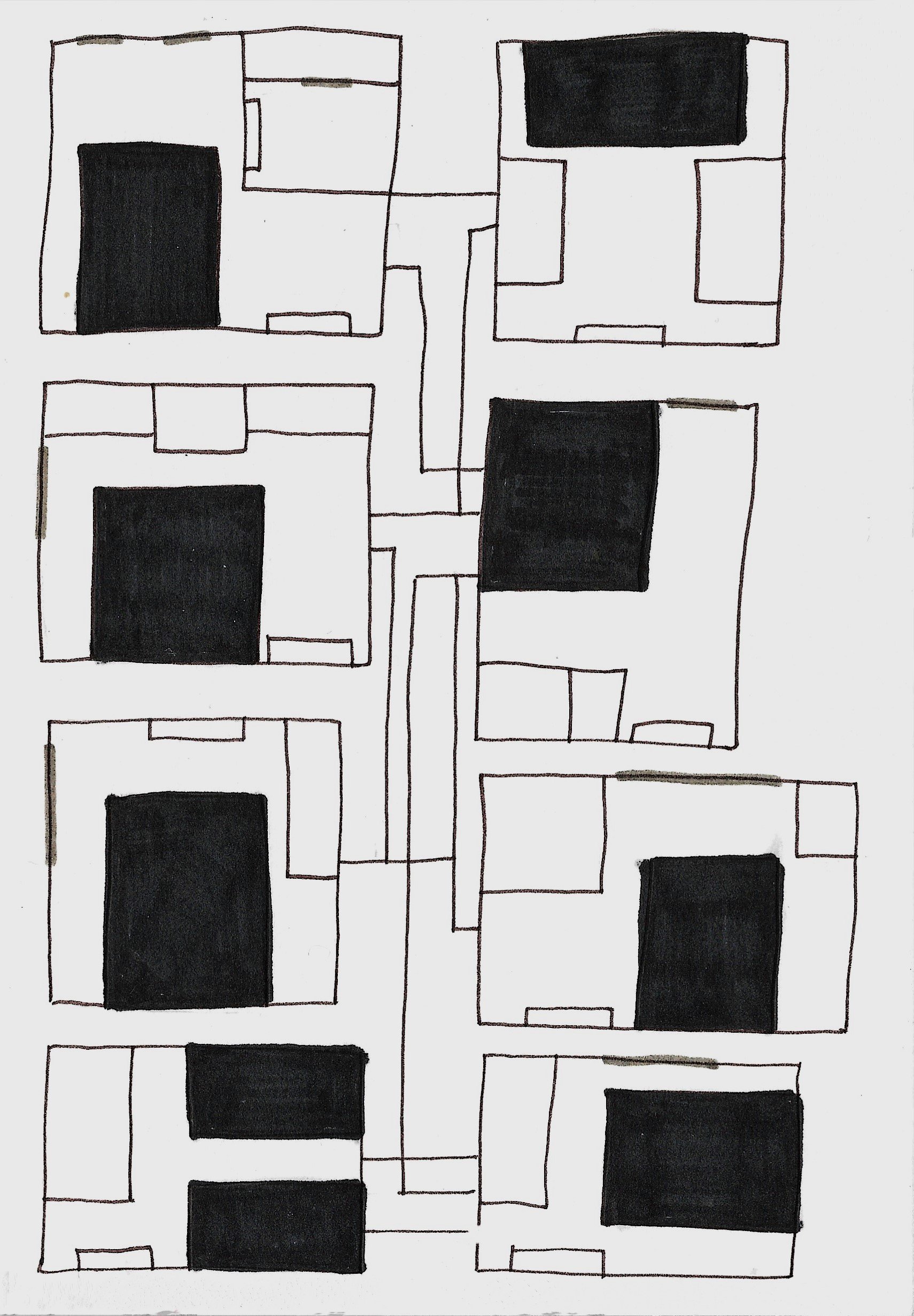resolved works, tests & works in progress
vernacular/assemblage workshop (photo: Juntong Wang)
linen bag, polyester stuffing, 25 cm
linen bag, polyester stuffing, 25 cm
Some of my first work in Unit 1 emerged from a Vernacular/Assemblage workshop in which we were given quick making/assembling tasks. This drew out ideas about forms of containment, the visual language of function and ambiguous form.
sketchbook page
Landlord Special, digital sketch
sketchbook page
calico floorplan, pockets, 25 x 35 cm
calico pockets, 24 x 37 cm
An expansion on an existing preoccupation with crude mapping of my spaces, particularly bedrooms. Sketches brought to mind other functions - pockets, storage. The small fabric works offered a kind of superficial function - recognisable but not useful. In dressmaking calico is associated with prototype and initial constructions; the fabric equivalent of a sketch - I was leaning into this association.
workspace with technical workshop output & WIPs
calico, plaster, 14 x 14 cm
calico, plaster, 14 x 14 cm
linen, plaster, 8 x 11 cm
sketchbook page
sketchbook page
WIP: child’s hula hoop, toilet paper inserts, modroc / 75cm
A continuation in thinking about forms of containment, more indications of function without use. Vessels, pockets, moveable parts.
linen, white thread embroidery, 10 cm
calico, 20 x 50 cm
sketchbook page
These fabric pieces were shown alongside the fabric pieces in the previous section in a WIP crit. Responses included a sense of surprise when they were picked up and interrogated. Someone instinctively put on the ruched calico piece (centre) like a sleeve. A sense of implied but unknown function. An interaction between the hard plaster and soft fabric. A feeling of expectation, unfinishedness.
Calico pieces shown in WIP Crit, 05/11/24
Moving away from the prototype associations of unbleached calico. Cotton twill - upholstery fabric, outerwear, aprons, boilersuits. Kitschy homemade chunky knit. For me, the hanger here is too explicit in its reference to garment. I would later consider the idea of armature/framework that would be built to correspond with its fabric counterpart.
carved polystyrene, cardboard, calico, PVA, 30 x 25 cm
WIP: carved expanding foam, cardboard, 23 x 31 cm
sketchbook page
These carved pieces were more reminiscent of architectural detail. Developing thoughts on form/surface relationship - the body for the skin/garment/cladding.
This work was shown in the MA Sculpture Pop Up show on 12/12/24.
The pink felt was reclaimed from an old project in small uneven pieces. When trimmed to into rectangles and sewn together, in my mind the resulting frankensteined sheet formed a kind of tabletop. I liked the detail of the seams on the ‘wrong’ side of the fabric, which changed the way I formed the work.
The irregular grid was read by some as the blueprint of a house, by some as fields seen from above or a bookshelf by others. The interaction of the geometry of the structure with the softness of its form and the almost labial folds of the pleats offers a kind of tension. It is an ambiguous object. It was displayed on the floor in the middle of the studio, existing in its own kind of liminal space.
sketchbook page
sketchbook page
cardboard prism, cotton 'clothes', 9 x 13 cm
cardboard prism, cotton 'clothes', 8 x 12 cm
sketchbook page
Moving forward I am looking to create some larger scale armatures that can be ‘dressed’ or upholstered with fabric. I want to play around with solid structures and hollow frameworks - the bodies that sit beneath the fabric.
iron soldering rods, cotton yarn, 25 x 12 cm
Considering the solidity of surface, perhaps where surface and form are inextricable. Playing with the positioning/installation. I like the mostly obscured copper skeleton that slightly peaks through.
technical workshops
plaster cast with wire, sand texture gel and pigment, 6 x 20 cm
press cast plaster, 16 cm
scored bronze sheet, 17 x 17 cm
enamelled copper, 4 x 4cm
soldered iron welding rods, 25 x 12 cm
The technical workshops have given me a good opportunity to consider some new materials - the range of materials in my work is typically fairly narrow. I find that these one-off sessions tend to both be informed by interests in my current practice and inform potential new lines of enquiry. I have found that metal in particular has drawn my attention; I’ve been interested in artists who subvert the minimalist form by borrowing from the visual language and somehow corrupting it.
textile research
I keep a stock of found and salvaged textiles and have been considering their textural potential. What really interests me is how steeped in association each textile can be; childhood, utility, luxury, kitsch…
Sun-bleached cotton lining from my old curtains. I brought this fabric in to a workshop at the beginning of Unit 1 as a material that reflected my vernacular as an artist. To me it represents one of the aspects that interests me most about fabric’s materiality: its propensity to reveal these kind of autobiographical elements.
Gathered calico. Playing with form/texture. More organic effect.
acrylic yarn knit
cotton yarn knit with oversized needles
cotton yarn knit with oversized needles
Thinking about this kind of kitschy homemade-ness in contrast to industrially manufactured fabrics. Oversized needles make the weave as open and warped as it can be.
patchworked velvet
Starting to look at patchworking. It began as a way to work small scraps into a larger workable sheet but I became interested in the way it mirrored the floorplan/ grids I had been considering previously.
patchwork/ pinned felt
felt detail
It was in the process of quilting together these pieces of pink felt that I became interested in the ‘wrong’ side of the fabric (i.e. the side with visible seams). They offered a kind of organic contrast to the grid composition. I was also drawn to the evidence of the fabric’s former life as part of another artwork: flecks of paint, small stains, hair.













































